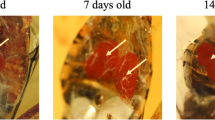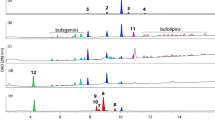Abstract
Larval release in the Caribbean spiny lobster Panulirus argus is highly synchronous and is controlled by a “pumping pheromone” released from the hatching eggs. The pheromone induces a parent female to undergo stereotypical larval release behaviors, including rapid abdominal extensions and pleopod pumping. These behaviors help to break open the egg membranes and result in the synchronous release of larvae. Based on previous studies on larval release in brachyuran crabs, we hypothesized that larval release behaviors are induced by pheromones composed of small peptides. We quantified pleopod pumping activity upon exposure to a range of synthetic peptides to identify compounds that will induce larval release behaviors. Chemically cued pumping behavior was described in terms of the threshold concentration for response, maximum percentage response, and effective concentration range. Pleopod pumping behavior was evoked by di- and tripeptides with a neutral amino acid at the amino terminus and a basic amino acid at the carboxy terminus and also by the basic–basic dipeptide Lys–Arg. All carboxy-terminal arginine peptides tested produced a significant pumping response, with the exception of Trp–Ile–Arg. Response concentration thresholds ranged from 10−9 M for the most potent peptide (Gly–Arg) to 10−4 M for the least potent (Gly–His–Lys). The maximum percentage of lobsters responding was largely independent of the threshold concentration and ranged from 24.3 to 58.3%. Effective concentration ranges for the peptides were variable from 1 to 4 orders of magnitude. Pumping response usually declined with increasing concentration beyond the concentration that evoked the maximum response of the peptides. Our results support the conceptual model that larval release in subtidal crustaceans is controlled by small peptides that act as pheromones.



Similar content being viewed by others
References
Atema, J. 1995. Chemical signals in the marine environment: dispersal, detection, and temporal signal analysis. Proc. Natl. Acad. Sci. USA. 92:62–66.
Branford, J. R. 1978. The influence of daylength, temperature and season on the hatching rhythm of Homarus gammarus. J. Mar. Biol. Assoc. UK. 58:639–658.
Browne, K. A., Tamburri, M. N., and Zimmer-Faust, R. K. 1998. Modeling quantitative structure-activity relationships between animal behavior and environmental signal molecule. J. Exp. Biol. 201:245–258.
Burke, R. D. 1984. Pheromonal control of metamorphosis in the Pacific sand dollar, Dendraster excentricus. Science. 225:442–443.
Decho, A. W., Browne, K. A., and Zimmer-Faust, R. K. 1998. Chemical cues: why basic peptides are signal molecules in the environment. Limnol. Oceanogr. 43(7):1410–1417.
DeCoursey, P. J. 1983. Biological timing, pp. 107–192, in D. E. Bliss, F. J. Vernberg, and W. B. Vernberg (eds.). The Biology of Crustacea: Behavior and Ecology, vol. 7. Academic, New York.
Derby, C. D., and Atema, J. 1988. Chemoreceptor cells in aquatic invertebrates: peripheral mechanisms of chemical signal processing in decapod crustaceans, pp. 365–388, in J. Atema, R. R. Fay, A. N. Popper, and W. N. Tavolga (eds.). Sensory Biology of Aquatic Animals. Springer, New York.
De Vries, M. C., and Forward, R. B., Jr. 1991a. Control of egg hatching time in crabs from different tidal heights. J. Crustac. Biol. 11:29–39.
De Vries, M. C., and Forward, R. B., Jr. 1991b. Mechanisms of crustacean egg hatching time: evidence for enzyme release by crab embryos. Mar. Biol. 110:281–291.
De Vries, M. C., Rittschof, D., and Forward, R. B. Jr. 1991. Chemical mediation of larval release behaviors in the crab Neopanope sayi. Biol. Bull. 180:1–11.
Ennis, G. P. 1973. Endogenous rhythmicity associated with larval hatching in the lobster Homarus gammarus. J. Mar. Biol. Assoc. UK. 53:531–538.
Ennis, G. P. 1975. Observations on hatching and larval release in the lobster Homarus americanus. Fish. Res. Board. Can. 32:2210–2213.
Fleck, J. 1998. Chemical fate of a metamorphic inducer in larvae-like buds of the cnidarian Cassiopea andromeda. Biol. Bull. 194:83–91.
Forward, R. B., Jr. 1987. Larval release rhythms of decapod crustaceans: an overview. Bull. Mar. Sci. 41:165–176.
Forward, R. B. Jr., and Lohmann, K. J. 1983. Control of egg hatching in the crab Rhithropanopeus harrisii (Gould). Biol. Bull. 165:154–166.
Forward, R. B. Jr., Rittschof, D., and De Vries, M. 1987. Peptide pheromones synchronize crustacean egg hatching and larval release. Chem. Senses. 12:491–498.
Mathews, C. K., Van Holde, K. E., and Ahern, K. G. 1999. Biochemistry. Addison Wesley Longman, San Francisco.
Moller, T. H., and Branford, J. R. 1979. A circadian hatching rhythm in Nephrops norvegicus (Crustacea: Decapoda), pp. 391–397, in E. Naylor, and R. G. Hartnoll (eds.). Cyclic Phenomena in Marine Plants and Animals. Pergamon, Oxford.
Morgan, S. G. 1995. The timing of larval release, pp. 157–191, in L. McEdward (ed.). Ecology of Marine Invertebrate Larvae. CRC, Boca Raton.
Morse, A. 1988. The role of algal metabolites in the recruitment process, pp. 463–475, in M. Thompson and R. S. Nagabhushanam (eds.). Marine Biodeterioration: Advanced Techniques Applicable to the Indian Ocean. Oxford, Bombay.
Pettis, R. J., Erickson, B. W., Forward, R. B. J. R., and Rittschof, D. 1993. Superpotent synthetic tri-peptide mimics of the mud-crab pumping pheromone. Int. J. Peptide Protein Res. 42:312–319.
Rittschof, D. 1993. Body odors and neutral-basic peptide mimics: a review of responses by marine organisms. Am. Zool. 33:487–493.
Rittschof, D., and Cohen, J. H. 2004. Crustacean peptide and peptide-like pheromones and kairomones. Peptides. 25:1503–1516.
Rittschof, D., Forward, R. B. Jr., and Mott, D. D. 1985. Larval release in the crab Rhithropanopeus harrisii (Gould): chemical cues from hatching eggs. Chem. Senses. 10:567–577.
Rittschof, D., Forward, R. B. Jr., Simons, D. A., Reddy, P. A., and Erickson, B.W. 1989. Peptide analogs of the mud crab pumping pheromone: structure-function studies. Chem. Senses. 14:137–148.
Rittschof, D., Forward, R. B. Jr., and Erickson, B. W. 1990a. Larval release in brachyuran crustaceans: functional similarity of the peptide pheromone receptor and the catalytic site of trypsin. J. Chem. Ecol. 16:1359–1370.
Rittschof, D., Kratt, C. M., and Clare, A. S. 1990b. Gastropod predation sites: The role of predator and prey in chemical attraction of the hermit crab Clibanarius vittatus. J. Mar. Biol. Assoc. UK. 70:583–596.
Rittschof, D., Tsai, D. W., Massey, P. G., Blanc, L., Kueber, G. L., and Haas, R. J. 1992. Chemical mediation of behavior in hermit crabs: alarm and aggregation cues. J. Chem. Ecol. 18:959–984.
Tankersley, R. A., Bullock, T. M., Forward, R. B. Jr., and Rittschof, D. 2002. Larval release behaviors in the blue crab Callinectes sapidus: role of chemical cues. J. Exp. Mar. Biol. Ecol. 273:1–14.
Tegtmeyer, K., and Rittschof, D. 1989. Synthetic peptide analogs to barnacle settlement pheromone. Peptides. 9:1403–1406.
Walther, M., and Fleck, J. 1998. Synthetic peptides inducing metamorphosis in a tropical jellyfish: a quantitative structure–activity relationship study. Comp. Biochem. Physiol. A. 120:655–659.
Yeung, C., and Lee, T. N. 2002. Larval transport and retention of the spiny lobster Panulirus argus, in the coastal zone of the Florida Keys, USA. Fish. Oceanogr. 11:286–309.
Zar, J. H. 1999. Biostatistical Analysis. Prentice Hall, New York.
Ziegler, T. A., and Forward, R. B. Jr. 2007. Control of larval release in the Caribbean spiny lobster, Panulirus argus: role of chemical cues. Mar. Biol. (in press) DOI: 10.1007/s00227-007-0712-2
Acknowledgements
This material is based in part on research supported by the National Science Foundation grant number OCE-0221099 and ECOHAB grant number NA170P2725, with additional funding from the Oak Foundation. All research was conducted according to the conditions of the FFWCC Special Activities License #05SR-9340. We thank Lonny Anderson, Dr. Mary Alice Coffroth, Todd Hitchins, Matthew Hoxie, Karen Neely, Daniel Poland, and Adrianna Zito for support with lobster collection. Gary Dickinson and Joshua Osterberg provided valuable comments to the manuscript. We also thank Dr. Dan Rittschof for helpful suggestions with the design and analyses of these experiments.
Author information
Authors and Affiliations
Corresponding author
Rights and permissions
About this article
Cite this article
Ziegler, T.A., Forward, R.B. Larval Release Behaviors in the Caribbean Spiny Lobster, Panulirus argus: Role of Peptide Pheromones. J Chem Ecol 33, 1795–1805 (2007). https://doi.org/10.1007/s10886-007-9335-9
Received:
Revised:
Accepted:
Published:
Issue Date:
DOI: https://doi.org/10.1007/s10886-007-9335-9




